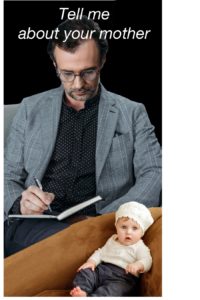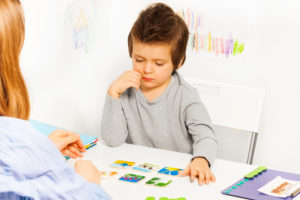 Therapy for autism has a long and sordid history. Psychoanalysts, following Sigmund Freud’s belief that abnormal behavior was caused by repressed childhood traumas, claimed to cure children who suffered from a “lack of attachment,” until therapists took over and made the same claims. The history of therapy for autism is shocking, but it has a happy ending. Some children with autism are cured by therapy. This type of therapy diverges radically from the misguided treatments imposed on innocent children for decades. These children made history, as true heroes do, and deserve our reverence and our gratitude. Here is their story.
Therapy for autism has a long and sordid history. Psychoanalysts, following Sigmund Freud’s belief that abnormal behavior was caused by repressed childhood traumas, claimed to cure children who suffered from a “lack of attachment,” until therapists took over and made the same claims. The history of therapy for autism is shocking, but it has a happy ending. Some children with autism are cured by therapy. This type of therapy diverges radically from the misguided treatments imposed on innocent children for decades. These children made history, as true heroes do, and deserve our reverence and our gratitude. Here is their story.
In 1956, at Chicago’s Orthogenic School, Dr. Bruno Bettelheim began “curing” children with autism using psychoanalysis. Psychoanalysis used regression techniques to help children revisit stages of their original separation traumas, and recover the love and attachment that their mothers denied them in early infancy, causing their autism. These mothers who were so “cold” that they caused autism were named “Refrigerator Mothers.” (Douglas, 2014; PBS Premiere, 2000).
Though she may not have consciously espoused Freudian psychology, Martha Welch invented holding therapy for reactive detachment disorder in 1988 (Welch, 1988). By its very designation, “reactive detachment” gave credence to the Freudian notion that the “detachment” observed in children with autism was a “reaction” to the separation trauma caused by Refrigerator Mothers. In 2005, Richard Simpson claimed that holding therapy effected a full recovery for children with autism (Research Autism, 2017).
Freud has more recent proponents who claim that, far from unscientific, “brain plasticity” explains the successes of psychoanalysis. In The Brain That Changes Itself: Stories of Personel Triumph from the Field of Brain Science, Doidge writes, “In terms of plasticity, such regression, I believe, involves unmasking old neuronal pathways that then trigger all associations of that earlier phase.” (Doidge, 2007).

Dr. Bruno Bettelheim
(1903-1990)
In 2008, Geraldine Dawson published an influential paper entitled Early Behavioral Intervention, Brain Plasticity, and the Prevention of Autism Spectrum Disorder (Dawson, 2008).
Though Dawson’s thesis was an optimistic endorsement of early detection and behavioral intervention, the words, plasticity and prevention, seem to have opened the floodgates for a stanch proponent of psychoanalysis. In 2014, William Singletary published An Integrative Model of Autism Spectrum Disorder: ASD as a Neurobiological Disorder of Experienced Environmental Deprivation, Early Life Stress and Allostatic Overload. Singletary cites Dawson 20 times, attributing autism to the “experience of early deprivation of growth-promoting parental input and psychological stress” (Singletary, 2015, p. 84). The “atrophy” of the “social brain” cannot only be prevented, but also be reversed by greater empathy from parents, through the mechanisms of neuroplasticity and family therapy. In a word, Singletary recommends an updated version of Dr. Bettelheim’s infamous “love cure,” despite Bettelheim’s exposure as a fraud by his biographer and the Chicago Tribune (Grossman, R., 1997; Pollak, R. 1998). Singletary’s article appears in the journal, Neuropsychoanalysis.
Psychoanalysts still claim to cure the dearth of parental empathy, even when they do not claim to cure autism, leaving others tomake the causal connection. In a 2008 CBS news report, Denise Mann described psychoanalysts as able to translate what a person with autism is thinking in terms understandable to his parents (Mann, 2008).

Family Therapy for “Lack of Attachment” in the Identified Patient with Autism
To be fair, psychoanalysis, once the therapy of choice for all psychiatric conditions, has been widely discredited for any psychiatric condition, even without the taint of such absurdities as regression therapy for toddlers with autism. But the premises of psychoanalysis have been absorbed by the widespread practice of psychotherapy.
Sigmund Freud (1865-1939) believed that repressed emotional conflict is expressed in inappropriate behaviors, like the kind seen in autism. This was the inspiration for holding therapy, which encouraged babies to release feelings of sadness and rage as they were held against their will (Pignotti, 2007). Even if this procedure released pent-up emotions, there is no evidence that the process would make anyone psychologically healthier. To the contrary, there is overwhelming evidence that PTSD is a pathological condition caused by the reliving of past traumas and their attendant emotions. Benefits claimed by the early supporters of holding therapy have not been validated in controlled studies (Research Autism, 2017; Herbert, 2002).

Holding Therapy encouraged babies to release feelings of sadness and rage as they were held against their will. (Research Autism, 2017; Herbert, 2002).
Dyadic Developmental Psychotherapy seems to be based on the psychoanalytic principle of regression by an older child to an earlier stage of development with the aim of recovering skills that were never quite mastered. There is no credible evidence that regression therapy works to recover lost memories, or that, if recovered, lost memories would facilitate new learning (Pignotti, 2007).
It is difficult to find recent scholarship that supports or opposes psychoanalytic cures for autism, perhaps because experts believe that psychoanalysis is not worth considering. Despite the preeminence of psychoanalysis during his time, even Leo Kanner, one of the first men to discover autism, proposed a biological basis for the disorder (Kanner, L. 1943). Biologists, geneticists, and epidemiologists seem to have won the debate.
Paradoxically, the other scholarly consensus is that there is therapy that works! The cures proffered by psychoanalysts have resulted in so much cynicism about therapy that researchers in behavioral therapy (Applied Behavior Analysis) refer to the absence of symptoms in a child who responded to therapy as an “optimal outcome” not a “recovery.” In the face of such cautious optimism, it could be said that these children survived the disease, but not the diagnosis.
Whether brain plasticity explains the reversal of symptoms or not, Dawson’s contention that early behavioral intervention can cure autism was not far off the mark (Dawson, 2008). In a report in New York Times Magazine, correspondent Ruth Padawer tried to make sense of emerging data about children who do recover (Padawer, 2014). A recent study conducted at Cornell Medical College found that, of 142 children diagnosed with autism by 37 months of age,“9% of participants had largely overcome core difficulties associated with autism and no longer retained a diagnosis.” Fully one quarter of the children with a non-verbal I.Q. of 70 or above recovered (Anderson, 2013, p. 485). Another study conducted out of the University of Connecticut followed 34 young people who had recovered from autism, comparing their treatment histories with 44 high-functioning children who had not recovered (Orinstein, 2014).

Patient with ABA Therapist
What “the kids who beat autism” have in common is some mysterious genetic advantage, early intervention, and the extensive involvement of parents and professionals. Those who do not believe in behavioral therapy (Applied Behavior Analysis), might ask themselves why symptoms become comparatively less severe in populations who receive ABA therapy. Those who do believe in ABA therapy might ask themselves why the only therapists who can sometimes cure autism take the official position that “there is no cure.” Perhaps they do not want to be associated with the false claims and dubious theories of their predecessors.
References
Anderson, D., Liang, J. W., & Lord, C. (2013) Predicting Young Adult Outcome Among More and Less Cognitively Able Individuals with Autism Spectrum Disorders. Journal of Child Psychology and Psychiatry, (55)5,485–494.
Dawson, G. (2008) Early Behavioral Intervention, Brain Plasticity, and the Prevention of Autism Spectrum Disorder. Development and Psychopathology, (20)3, 775–803.
Doidge, N. (2007) The Brain That Changes Itself: Stories of Personal Triumph From the Field of Brain Science. NY: Viking Press.
Douglas, P. (2014) Autism’s “Refrigerator Mothers”: Identity, Power, and Resistance. Comparative Programs on Health and Society (CPHS) Working Paper Series, 2013-2014. Toronto, CA: Munk School of Global Affairs.
Grossman, R. (1997, January 30). Genius Or Fraud? Bettelheim’s Biographers Can’t Seem To Decide.Chicago Tribune, p. 2. Retrieved from http://articles.chicagotribune.com/1997-01-23/features/9701230196_1_orthogenic-school-bruno-bettelheim-pollak/2
Herbert, J. D., Sharp, I. R., Gaudiano, B. A. (2002) Separating Fact from Fiction in the Etiology and Treatment of Autism: A Scientific Review of the Evidence. The Scientific Review of Mental Health Practice, (1)1Retrieved from https://www.srmhp.org/0101/autism.html
Kanner, L. (1943) Autistic Disturbances of Affective Contact. Nervous Child 2, 217-250.
Mann, D. (2008, January 25) Psychoanalysis Helps Kids With Autism. CBS News Interactive Inc. Retrieved fromhttps://www.cbsnews.com/news/psychoanalysis-helps-kids-with-autism.
Orinstein, A., Helt, M., Troyb, E., Tyson, K., Barton, M. L., Eigsti, I., Naigles, L., & Fein, D. A. (2014) Intervention History of Children and Adolescents with High-Functioning Autism and Optimal Outcomes. Journal of Developmental & Behavioral Pediatrics, 35(4), 247–256.
Pawader, R. (2014, July 31) The Kids Who Beat Autism. The New York Times Magazine. Retrieved from https://www.nytimes.com/2014/08/03/magazine/the-kids-who-beat-autism.html.
PBS Premiere (2002) History of Autism Blame Retrieved from http://www.pbs.org/pov/refrigeratormothers/fridge/
Pignotti, M., Mercer, J. (2007) Holding Therapy and Dyadic Developmental Psychotherapy Are Not Supported and Acceptable Social Work Interventions: A Systematic Research Synthesis Revisited. Research on Social Work Practice 17(4), 513-518.
Pollak, R. (1998) The Creation of Doctor B: A Biography of Bruno Bettelheim.
Research Autism: Improving the Quality of Life, Identification, Intervention, Inclusion (2017) Holding Therapy and Autism. 393 City Road,London EC1V 1NG. Retrieved from http://researchautism.net/interventions/71/holding-therapy-and-autism?print=1.
Singletary, W. M. (2015) An Integrative Model of Autism Spectrum Disorder: ASD as a Neurobiological Disorder of Experienced Environmental Deprivation, Early Life Stress and Allostatic Overload. Neuropsychoanalysis,(17)2, 81-119.
Welch, M. G. (1988) Holding Time. NY: Simon & Schuster.

One Response to Does Therapy Cure Autism?